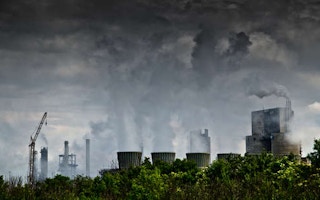WASHINGTON, DC – Coal is emerging as a major topic of conversation at the United Nations climate-change negotiations currently taking place in Warsaw – and rightly so. Indeed, it is a discussion that the world needs to have.
To continue reading, subscribe to Eco‑Business.
There's something for everyone. We offer a range of subscription plans.
- Access our stories and receive our Insights Weekly newsletter with the free EB Member plan.
- Unlock unlimited access to our content and archive with EB Circle.
- Publish your content with EB Premium.
The latest findings of the Intergovernmental Panel on Climate Change conclude that we are quickly using up our carbon “budget” – the amount of carbon that we can afford to emit while still having a good chance of limiting global warming to 2º Celsius. According to the IPCC, keeping the global temperature increase from pre-industrial levels below this threshold – the recognized tipping point beyond which climate change is likely to get seriously out of control – requires that the world emit only about 1,000 gigatonnes of carbon (GtC). More than half of this amount was already emitted by 2011. Unless we shift away from carbon-intensive behavior, the remaining budget will run out in roughly three decades.
When it comes to tolerable CO2 emissions, coal is the budget buster. Just this week, a group of 27 prominent scientists, representing all major continents, issued a joint statement that explains that burning all known fossil-fuel reserves would produce about 3,800 gigatonnes of CO2, or 1,053 GtC, with coal alone accounting for more than half. Simply put, if the world burns its known coal reserves using current technologies, it is likely to push global temperature rise far beyond 2ºC.
Many governments and financial institutions recognize this. In recent months, the World Bank, the European Investment Bank, and the United States Export-Import Bank have introduced policies that restrict financing of new coal-fired power plants unless they can capture and store their CO2 emissions. Five Nordic countries have joined the US Treasury in ending public financing of new coal-fired power plants overseas, and others may soon follow suit. And this fall, the US Environmental Protection Agency proposed emissions standards for new power plants that would rule out conventional coal power – an important step that would cut carbon pollution and drive innovation.
Likewise, China, concerned about the serious health costs linked to burning coal, is prohibiting new coal capacity in three coastal provinces under its newly adopted action plan on air pollution. The Chinese authorities have also introduced policies to reduce the proportion of coal in the country’s overall energy mix.
“
The WCA is calling for the use of “high-efficiency, low-emissions coal-combustion technologies” to lower greenhouse-gas emissions from coal-fired power plants around the world. But this approach would still consume too much of the CO2 budget
Against this backdrop, the World Coal Association (WCA) is meeting this week, also in Warsaw – in fact, just across the river from where negotiators are trying to forge the building blocks of a global climate agreement by 2015.
The WCA is calling for the use of “high-efficiency, low-emissions coal-combustion technologies” to lower greenhouse-gas emissions from coal-fired power plants around the world. But this approach would still consume too much of the CO2 budget. Even the most modern and advanced conventional coal-fired power plants emit over 15 times more CO2 per unit of electricity than renewable energy systems, and more than twice the amount of efficient gas-fired power stations.
And yet coal power is still going strong globally. The World Resources Institute estimates that there are close to 1,200 proposed coal-fired power projects around the world, with a total installed capacity of more than 1,400 gigawatts. If built, the world would commit a large share of the remaining carbon budget to high-carbon infrastructure with a lifespan of 40-50 years.
According to the International Energy Agency, the current trend in coal use is in line with a scenario that would lead to a 6ºC temperature rise. This is a future that would radically and irreversibly change life on earth as we know it.
This is why the OECD Secretary General has suggested that it is time for a moratorium on the construction of conventional coal-fired power plants. Governments have far more cost-effective electricity-generation technologies at their disposal. Renewable energies like solar and wind are already competitive with fossil fuels in many parts of the world, and they can be scaled up rapidly.
Moreover, most economic models do not account for the externalities related to coal and carbon pollution. For example, a recent report by Trucost estimates that coal-fired power generation worldwide may be responsible for around $1 trillion of damage due to climate change and air pollution. Many coal-fired power plants would be uncompetitive if they were required to internalize these costs.
Of course, coal continues to offer millions of people a reliable source of electricity – and the transition to low-carbon technologies will not happen overnight. We need to expand access to these technologies rapidly, while helping people whose livelihoods depend on the coal industry. While we need to be passionate about climate change, we must also be pragmatic about how we address it.
But so must the coal industry. Participants at the WCA meeting this week should commit to additional measures that will help ensure that emissions are kept within safe limits. A moratorium on conventional coal plants would be a smart place to start. That would help to show the world that the coal industry truly understands the scientific implications of current energy-use patterns, and that it is willing to assume more responsibility for combating climate change.
We need people on both sides of the Vistula River to do their part to build a fair and ambitious universal climate agreement by 2015. Let’s roll up our sleeves together and plot a viable pathway to a safe and effective low-carbon economy.
Andrew Steer is President and CEO of the World Resources Institute. This post originally appeared here.











